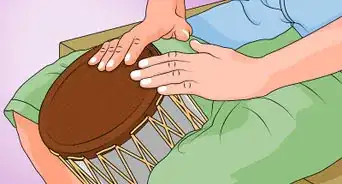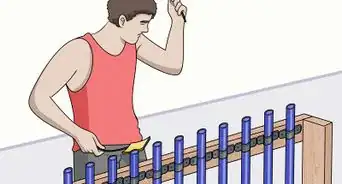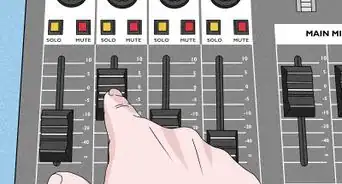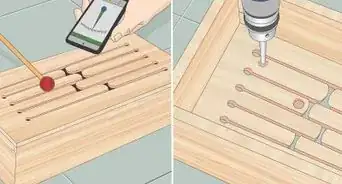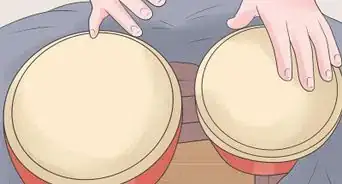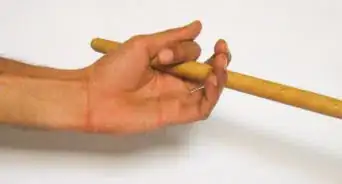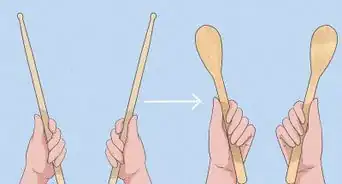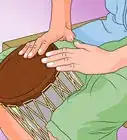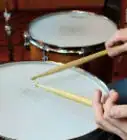wikiHow is a “wiki,” similar to Wikipedia, which means that many of our articles are co-written by multiple authors. To create this article, 18 people, some anonymous, worked to edit and improve it over time.
wikiHow marks an article as reader-approved once it receives enough positive feedback. In this case, 88% of readers who voted found the article helpful, earning it our reader-approved status.
This article has been viewed 627,888 times.
Learn more...
A cajon is a six-sided Peruvian drum that's a popular DIY instrument project. It's a versatile and exciting instrument that can be played with your hands and feet simultaneously, producing a wide variety of tones and rhythms. You can take on this carpentry project with the right materials and a good plan. See Step 1 for more information.
Steps
Getting Started
-
1Get enough plywood to build your cajon. Generally, a cajon is made of two different thicknesses of wood, thinner for the striking surface and slightly thicker for the rest of the instrument.[1]
- Use 1/8 inch plywood for the tapa. The tapa is the striking surface of the instrument, and you'll generally use a piece sized 13 inch by 19 inch for most cajons.
- For the other sides of the instrument, use 1/2 inch plywood.
-
2Cut out the required sheets of plywood. Prepare the body of the cajon by cutting the correct measurements to form the basic box. Make sure the cuts are very straight by clamping a metal ruler to the sheet of plywood and using a jigsaw or circular saw.
- The top and bottom pieces should be 13 inch by 13 inch
- The single rear piece should be 13 inch by 18 inch
- The sides should be 12 1/2 inch by 18 inch
Advertisement -
3Trace a 12cm diameter hole on the rear piece. Drill a hole towards the edge of the marked sound hole, and use that as a starting point to cut out the sound hole with a jigsaw.
- Round and sand the edges to create an even and clean edge.
-
4Fashion your snares. One of the distinctive things about the sound of the cajon is the snare-drum-like rattle made when hitting the tapa. This comes from attaching several strings of snares you can either make yourself, salvage from an old snare drum, or use new snares and attach to the inside of the drum.[2]
- A snare is basically a string or wire stretched to tension and outfitted with something that rattles. If you wanted to make your own, using old guitar strings, fishing line, or other wire would be perfectly appropriate for a homemade cajon. For rattles, try paperclips, sinkers, or other tiny metal salvaged materials that make a good rattling sound.
Gluing the Frame
-
1Glue the basic frame. Start with the base and one of the side pieces, applying a liberal amount of wood glue. Next, glue the other side piece and the top to create the basic frame.
- Have a helper steady the pieces as you add the glue and keep them as straight as possible, or cut guide pieces to keep inside the box and ensure straight angles.
-
2Apply pressure. Big carpentry clamps would be ideal, but luggage straps will do in a pinch. Strap ample pressure to the piece while the wood glue dries. Let it sit for several hours before adding the back, tapa, and snares.
- Wipe off any excess glue with a wet cloth and read the instructions for the particular variety of wood glue you purchase for advice about pressure and drying time.
-
3Attach the snares before gluing on the tapa. Depending on what you're using for snares, you can do this in a variety of different ways. Ideally, you might purchase some tuning pegs from the music store to be able to "tune" the snares periodically.
- Stretch the snares diagonally from the top corners of the side that will be the tapa, roughly 3 inches from each corner on the top and on the side. Screw them in with wood screws, or attach them to tuning pegs for more control over the sound.
-
4Glue on the tapa and the back piece. Apply the front and back piece as before and apply pressure for the same length of time. Orient the back piece so that the sound hole is at the base of the instrument, and the snares are at the top. You might also consider applying wood screws for added stability in your instrument. You're going to be sitting on it, so it's worth putting some extra strength into it.
Finishing the Cajon
-
1Cut out feet from leftover pieces of wood and screw them to the bottom. Rubber or cork can also be used. It's ideal to have a somewhat cushioning surface to set the box on, since it's going to be holding up your weight as well. Putting plywood on the ground can scratch some surfaces.
-
2Round the top side corners to make it more comfortable to sit on. Use sandpaper and take some time smoothing out the edges and the surfaces. Sand your cajon with progressively finer sanding paper, then finish to your liking.
-
3Give it some flair. Decorate the instrument with your own personal style. Finish it with wood stain for a professional and classy look, or hook it up with psychedelic Neptunes and polar bears for a wild hippie look. Have fun with it.
Community Q&A
-
QuestionWhere can I get the 1/2 inch plywood?
 Community AnswerAny "big box" hardware store (i.e. Home Depot or Lowe's) will have both 1/8" and 1/2" plywood in various sizes. Neighborhood hardware stores are not likely to have all the plywood that you need.
Community AnswerAny "big box" hardware store (i.e. Home Depot or Lowe's) will have both 1/8" and 1/2" plywood in various sizes. Neighborhood hardware stores are not likely to have all the plywood that you need. -
QuestionThis has a base in the center near the bottom of the drum, and then the snares are in the top corners, right?
 Jelke de JongCommunity AnswerYes, absolutely correct! Of course, you will need to employ the proper striking techniques to really get the most out of those sounds, but that's the main idea of it.
Jelke de JongCommunity AnswerYes, absolutely correct! Of course, you will need to employ the proper striking techniques to really get the most out of those sounds, but that's the main idea of it. -
QuestionCan this be spray painted?
 Community AnswerYes. However, keep in mind that adding paint might change the sound because of its weight and structure.
Community AnswerYes. However, keep in mind that adding paint might change the sound because of its weight and structure.
Warnings
- Protect your eyes and ears when working with power tools. Wear safety glasses and earplugs or earmuffs.[3]⧼thumbs_response⧽
Things You'll Need
- 12mm (or 1/2 inch) plywood
- 3mm (or 1/8 inch) plywood
- jigsaw
- Clamps and/or luggage straps
- Wood glue
- 3x20mm or 3.5x20mm screws
- Power drill
- Wood rasp
- Sanding paper
References
About This Article
To build a cajon, you'll need 1/8 inch plywood for the striking surface of the instrument and 1/2 inch plywood for the sides. Then, cut out a top and bottom piece that are both 13 inches by 13 inches, a rear piece that's 13 inches by 18 inches, and 2 sides that are each 12 1/2 inches by 18 inches. Also, on the rear piece, cut out a 12-centimeter hole. Next, assemble the frame using wood glue and attach snares to the side that will be the striking surface. Finally, screw some wooden feet into the bottom of your cajon and smooth out the top edges so it's comfortable to sit on. To learn how to make your own snares for your cajon, scroll down!
